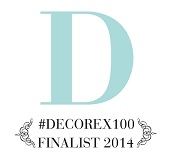My Latest Online Obsession
 Thursday, April 28, 2016 at 3:00AM |
Thursday, April 28, 2016 at 3:00AM |  Laurie Gorelick Interiors
Laurie Gorelick Interiors I may be late to the party, but I've just discovered a fantastic web site for those of us, like me, obsessed with getting a bargain. This revelation is dangerous because I've been known in the past to do a bit of damage on some flash sale sites (that shall remain nameless and that I've since unsubscribed from). My new obsession is called Everything But The House and is an online source for estate sales. While I just became aware of it about a month ago, I discovered that it's has been around since 2008.
Everything But The House sells everything from cars, antiques, jewelry, art, china, furniture, collectibles and more. It has outposts in 20 cities around the country and hosts about 180 estate sales a month. All sales are auction format starting at bids of $1 and last for seven days. I recently scored two items, a vintage Persian Lamb fur jacket that cost me $15 (actually $35 but I had a $20 opening credit) and a Gemma Redux necklace for $18. The necklace, new, was probably around $350-400 retail!
When bidding on an item, you can type in your zip code and get a quote for shipping. If you track the sales in your vicinity, you can pick up items and save on shipping costs. For large items like furniture, the pick-up option would offer considerable savings. For example, I spotted a sale in Wellesley, Massachusetts, just a couple of miles down the road from me, offering a whole dining room set, an office suite from Chaddock complete with desk and credenza, and a suite of Brown Jordan outdoor furniture, all for a song! The following items are also part of that sale:


As I write this post, the current bid on the Lee Jofa club chair on the left, above, is $2, and the bid on the Wellington Hall Hepplewhite Style sideboard, above right, is $22. These items originally cost thousands of dollars.
Like house hunting, don't judge these furnishings on first glance. Anything can be refinished, repainted and re-upholstered. So even if Hepplewhite is not your style, it's worth a look.






























